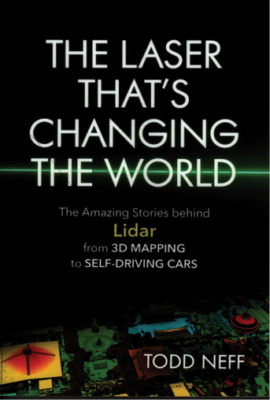
- Prometheus Books, Amherst,
New York, 2018. - 228 x 154 mm, 314 pp
- 24 black and white illustrations, numerous notes and references, index.
- Paperback,
ISBN 978-1-63388-466-3, $19.00. - Also e-book,
ISBN 978-1-63388-467-0, $11.99.
Unlike most books reviewed in these pages, The Laser That’s Changing the World: The Amazing Stories behind Lidar from 3D Mapping to Self-Driving Cars is not an academic tome but a popular work, aimed at the mass market. Todd Neff is an award-winning science, environment and healthcare journalist, who decided that lidar people, technologies and applications are sufficiently interesting and significant to bring them to the attention of readers worldwide.
Editor’s note: A PDF of this article as it appeared in the magazine is available HERE.
My heart pounded at the title of the first chapter, “Hutchie”, the nickname of the traditional institution of education I attended for middle and high school in Scotland. No, of course not, it’s about Edward Hutcheson Synge, an Irishman who figured strongly in the early days of lasers. Yet I was not entirely disappointed at the lack of links to Scotland: I learned that Allan Carswell’s mother hailed from the Isle of Lewis, a dreich, windswept, evocative island off Scotland’s west coast. It was one of those pleasing coincidences that when I read the section on Optech’s early days, my bedtime reading was The Black House, the second volume of Peter May’s Lewis trilogy.

Author Todd Neff
The 17 short chapters encompass remarkable breadth. There is so much to celebrate about lidar—scientific and engineering breakthroughs on the one hand and valuable improvements to the quality of life of our planet’s inhabitants on the other. There are chapters on the early history, then the book follows a structure where a development used for a particular application is described and its advances and adoption traced, often ending with a segue into the next chapter. Neff frequently refers back to earlier developments that provided foundations or components for the one being discussed, an approach that deepens the appeal of the book. He’s not afraid to draw in complementary technologies, such as radar, sonar or GPS, where appropriate. Readers will vary in their preferences, but your reviewer found the material on space, archaeology and autonomous vehicles to be engaging; the narrative surrounding the various DARPA challenges is riveting. One of the prevailing themes is the remarkable abilities of the inventors and developers who made the big advances. Neff’s tributes, moreover, frequently stress these pioneers’ acumen in actually making things—cutting metal, joining wires and pipes, buying components and so on—while fully exploiting their brilliance in physics, engineering or other specialisms.
The book’s scope reminds those of us from the geospatial world that we have no monopoly on the use of lidar. Surveying and mapping, massively important as they are, benefit from lidar’s precise positioning, while diverse applications, such as detection of gas leaks, use other features of the technology. It’s strange to open a popular book and feel like a spectator watching the very events described unfold. The book opens at the 2017 ILMF conference and chapter 12 visits the 2018 event. The front cover graphic is from Harris. There are numerous mentions of people we know, mostly encomia upon lidar’s movers and shakers, but some rather less reverent—the urbane Alistair Jenkins may or may not quibble at being described as a “guy with a high-end British accent” (page 113)! Neff does well to see so much, talk to so many experts, then distill what he has learned into succinct, captivating accounts.
Prometheus Books has produced this volume well. There are hardly any typos or obvious errors, though “Victoryville” ought probably to be “Victorville” (page 202). There are 38 pages of notes, in the style of a professional history or biography, authenticating statements in the book by referring to the author’s communications with people, providing references, or giving further information. These provide readers with a starting point to research lidar in more detail, especially the historical aspects. The 40-page index is helpful, for example to return to a development that the author cites in the context of something newer.
Some readers of LIDAR Magazine may quibble at Neff’s colloquial style and, indeed, a few words may cause difficulties for those whose variant of the English language is not the US one (we are hit by “grokking” as early as page 7, for example, and “not too shabby” on page 49; “hired” is apparently more intransitive than transitive). Others may tire of his repetitive descriptions of the innovators—the stars with whom the book is studded—“Fred was born in x, got his PhD from y, joined z in 19xx, was wearing khakis and polo shirt when I met him, brewed tasty coffee and is a great guy” is not everyone’s ideal introduction, yet something along these lines is required to give the technologies a human slant while not compromising the book’s breathtaking pace. Experts may take issue with some of the historical or technical details—the link between forest measurement and Hugershoff, for example, may be worth another look.
Despite those dangers, The Laser That’s Changing the World: The Amazing Stories behind Lidar from 3D Mapping to Self-Driving Cars is a considerable achievement. Neff has made his short history of lidar into a compelling narrative and has brought the technology we cherish to life through straightforward explanations of principles and a pleasing focus on the characters whose achievements have justified the phrase, “We are standing on the shoulders of giants”. The blurb on the back cover includes endorsements from renowned lidar luminaries, so the book’s success is rightly off to a fast start. The lidar community ought to read this, as should general readers excited by modern technologies and the benefits they bring to society. Historians of lidar will find the book invaluable. Your reviewer will use it to brief himself before interviewing a company to prepare an article. Reasonably priced and requiring only a couple of evenings to read, this book should deservedly succeed. The one-page conclusion at the end of the final chapter promises more applications of lidar in the future, developed by new generations of brilliant, creative people. Let us hope that Neff keeps us informed of these with a second edition in a few years.